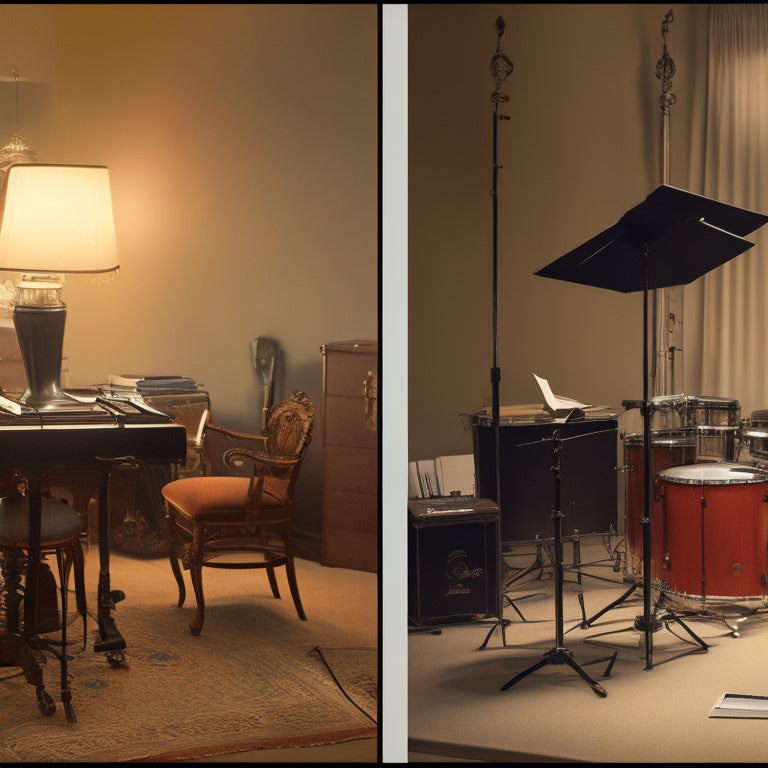
7 Rehearsal Schedule Templates for Optimal Practice
Share
You're looking for a rehearsal schedule that drives peak practice. With these 7 templates, you'll be able to set specific, measurable goals and track your progress. The Essential Weekly Practice Schedule helps you prioritize your time, while the Monthly Goal Setting Planner guarantees you're focusing on what matters most. The Daily Drills and Combo Tracker keeps you on top of your daily practice, and the Choreography Rehearsal Roadmap guides your rehearsals. The Music and Movement Planner, Performance Prep Countdown, and Seasonal Practice Objective Planner round out the suite. By implementing these templates, you'll be well on your way to achieving your goals - and discovering the secrets to excellent practice.
Key Takeaways
• Utilize the Essential Weekly Practice Schedule to allocate time for daily drills, goal-oriented rehearsals, and rest days for optimal performance.
• Set SMART objectives with the Monthly Goal Setting Planner to ensure consistent progress and track milestones.
• Implement the Daily Drills and Combo Tracker to monitor progress, identify areas for improvement, and adjust practice accordingly.
• Define specific rehearsal objectives with the Choreography Rehearsal Roadmap to maximize practice time and achieve goals.
• Prioritize high-impact tasks and effective time management with the Music and Movement Planner to ensure efficient practice sessions.
Essential Weekly Practice Schedule
You'll need a well-structured weekly practice schedule to guarantee consistent progress and ideal use of your time. This is essential for developing effective practice habits, which are necessary for achieving your goals. Without a clear plan, you'll struggle to make the most of your practice sessions, leading to frustration and stagnation.
To create a productive schedule, start by identifying your most important practice goals. What do you want to achieve in the short-term and long-term? Allocate specific times for each goal, ensuring you're dedicating sufficient time to each area. Be realistic about your commitments and availability, and prioritize your most critical tasks.
Effective time management is vital to a successful practice schedule. Set specific times for warm-ups, technique practice, and performance preparation. Make sure to include regular breaks to avoid burnout and maintain focus.
A well-planned schedule will help you stay on track, make the most of your time, and drive consistent progress. By adopting a structured approach, you'll develop powerful practice habits that propel you towards success.
Monthly Goal Setting Planner
Having established a weekly practice schedule, you can now focus on setting specific, measurable, and achievable goals for the month ahead, ensuring your daily efforts align with your long-term objectives. This is where your Monthly Goal Setting Planner comes in. This essential tool helps you reflect on your progress, identify areas for improvement, and set realistic targets for the next month.
Through goal reflection, you'll analyze your strengths, weaknesses, and areas that require extra attention. By doing so, you'll create a roadmap for success, breaking down large objectives into manageable, bite-sized tasks.
Habit formation is key to achieving your goals, and your Monthly Goal Setting Planner will help you create a routine that sticks.
Daily Drills and Combo Tracker
To take your practice to the next level, incorporate daily drills into your routine, and use a combo tracker to monitor your progress and identify areas that require extra attention. By doing so, you'll be able to refine your skills, build muscle memory, and develop consistency in your performances.
Create a list of drill variations that target specific skills or techniques you want to master. For example, if you're a dancer, you might focus on perfecting your pirouettes or improving your flexibility. Set aside a specific time each day to practice these drills, and track your progress using a combo tracker. This will help you identify patterns, strengths, and weaknesses, allowing you to adjust your practice accordingly.
As you work towards combo mastery, you'll start to notice improvements in your overall performance. You'll be able to execute complex combinations with ease, confidence, and precision. By incorporating daily drills and tracking your progress, you'll be well on your way to achieving peak performance and reaching your full potential.
Choreography Rehearsal Roadmap
As you create your Choreography Rehearsal Roadmap, you'll define specific objectives for each rehearsal, ensuring everyone's on the same page.
Next, you'll break down the choreography into manageable segments, making it easier to focus on perfecting each part.
Set Rehearsal Objectives
Your choreography rehearsal roadmap begins with defining clear objectives, which serve as benchmarks to measure progress and keep your team focused on achieving the desired performance quality. Establishing specific goals enables you to create a structured rehearsal plan, ensuring that every practice session is productive and efficient.
To set effective rehearsal objectives, consider the following key aspects:
-
Team Building:
Foster a positive and collaborative rehearsal culture by setting goals that promote teamwork, communication, and mutual respect among team members. -
Performance Metrics:
Define measurable performance metrics to assess your team's progress, such as mastering specific choreography segments or achieving a certain level of technical proficiency. -
Artistic Goals:
Align your objectives with your creative vision, ensuring that your rehearsal plan stays true to your artistic goals and overall performance concept.
Plan Choreography Segments
With clear objectives in place, you can now break down your choreography into manageable segments, allowing you to create a detailed rehearsal roadmap that focuses on perfecting specific sections of the performance. This will enable you to allocate sufficient time for each segment, ensuring that every aspect of your choreography is polished.
To plan your choreography segments, consider the following:
| Segment | Choreo Timing | Segment Flow |
|---|---|---|
| Opening Sequence | 0:00 - 0:30 | High-energy intro, setting the tone for the performance |
| Middle Section | 0:30 - 1:15 | Progression to slower tempo, showcasing emotional expression |
| Finale | 1:15 - 1:45 | Building energy, culminating in a grand finale |
Track Progress Timeline
Create a choreography rehearsal roadmap by charting your progress against specific milestones, ensuring you stay on track to perfect each segment of your performance. This visual representation of your rehearsal schedule helps you identify areas that need improvement and allocate practice time efficiently.
To maximize your progress, incorporate the following strategies into your roadmap:
-
Milestone reflection: Schedule regular check-ins to assess your progress, identify challenges, and adjust your practice plan as needed.
-
Performance analytics: Track your performance metrics, such as execution time, accuracy, and overall quality, to pinpoint areas that require additional practice.
-
Adjust and refine: Based on your milestone reflection and performance analytics, refine your practice plan to focus on the most critical segments of your choreography.
Music and Movement Planner
As you start planning your music and movement rehearsals, you'll need to prioritize your daily routine and allocate rehearsal space efficiently.
You'll want to create a schedule that balances practice time with rest and recovery, ensuring you're performing at your best.
Daily Routine Planning
By incorporating a daily routine planner into your music and movement activities, you can efficiently allocate time for rehearsals, lessons, and performances. This allows you to prioritize tasks, set realistic goals, and make the most of your practice sessions.
A well-structured daily routine helps you stay focused, motivated, and in control of your progress.
To maximize your daily routine, consider the following strategies:
-
Morning motivation: Start your day with a clear goal in mind. Set a specific objective for your practice session, and make it achievable.
-
Prioritize focused practice: Allocate dedicated time for focused practice, eliminating distractions and minimizing breaks.
-
Evening reflection: Review your progress, identifying areas for improvement and adjusting your approach for the next day.
Rehearsal Space Allocation
When allocating rehearsal space, you'll need to take into account the specific requirements of your music and movement activities, making sure that each area is optimized for its intended purpose. This means considering the unique demands of each activity, from the size and layout of the space to the equipment and resources needed.
To maximize space efficiency, you'll want to assess the room logistics and layout to guarantee a smooth flow of movement. Identify areas that can be multi-purposed, and allocate space accordingly. For instance, a mirrored wall can serve as a dance studio and a music practice area.
Consider the acoustics, lighting, and ventilation of the space, making sure they're suitable for your activities.
Performance Prep Countdown
You're now just four weeks away from the big performance, and it's time to kick your preparation into high gear. It's vital to stay focused and make sure you're making the most of your remaining time. Effective time management is key to achieving your performance goals.
To maximize your prep, implement these countdown strategies:
-
Prioritize high-impact tasks: Identify the most critical aspects of your performance that require attention and allocate your time accordingly.
-
Create a daily schedule: Break down your tasks into manageable chunks and assign specific times for practice, rest, and review.
-
Review and adjust: Regularly assess your progress, identify areas for improvement, and make adjustments to your schedule as needed.
Seasonal Practice Objective Planner
As you fine-tune your performance prep, it's equally important to plan your seasonal practice objectives to guarantee consistent progress throughout the year. A Seasonal Practice Objective Planner helps you stay focused and motivated by breaking down your goals into manageable chunks.
Start by identifying your Winter Goals, whether it's perfecting a new piece or refining your technique. Next, allocate specific practice sessions to tackle each objective, ensuring you're making steady progress.
Consider incorporating Holiday Themes into your practice routine to keep things engaging and fun. For instance, you could create a festive warm-up routine or practice holiday-themed repertoire.
Be precise when setting your objectives, making sure they're specific, measurable, achievable, relevant, and time-bound (SMART). This will help you stay accountable and motivated.
Frequently Asked Questions
What if I Need to Miss a Rehearsal, Can I Adjust the Schedule?
If you need to miss a rehearsal, don't panic! Consider a flexible Absence Policy, like the one adopted by the Seattle Opera, which allows for two excused absences per performer within a set timeframe, ensuring Flexibility Planning for all involved.
How Do I Prioritize Practice When I Have Multiple Roles?
When juggling multiple roles, you prioritize practice by creating a Role Hierarchy, then allocate dedicated Time Blocking for each role, ensuring focused attention and maximizing productivity.
Can I Customize the Templates for My Specific Performance Type?
"Will you settle for a one-size-fits-all approach or tailor your practice to your unique performance style? You can customize templates to fit your specific needs, leveraging template flexibility to maximize your performance potential."
Are These Templates Suitable for Solo Performers or Only Groups?
You'll find these templates adapt to your solo preferences, offering a tailored approach, while also catering to ensemble adaptability, ensuring a seamless rehearsal experience for both solo performers and groups alike.
Can I Use These Templates for Rehearsals Outside of Performance Art?
You can repurpose these templates for rehearsals outside of performance art, like business meetings or team building exercises, to streamline logistics, maximize productivity, and enhance collaboration.
Related Posts
-

5 Online Resources for Dance Makeup Inspiration
You can find endless dance makeup inspiration online! Start by browsing YouTube tutorials, where you'll discover comm...
-

Ballet Cut File Set: Versatile Designs Available
The Ballet Cut File Set offers a wide-ranging collection of versatile designs available in multiple formats, includin...
-

Captivating Ballerina SVG Designs for DIY Enthusiasts
Ballerina SVG designs have captured the interest of DIY enthusiasts and crafters, providing a versatile and sophistic...


